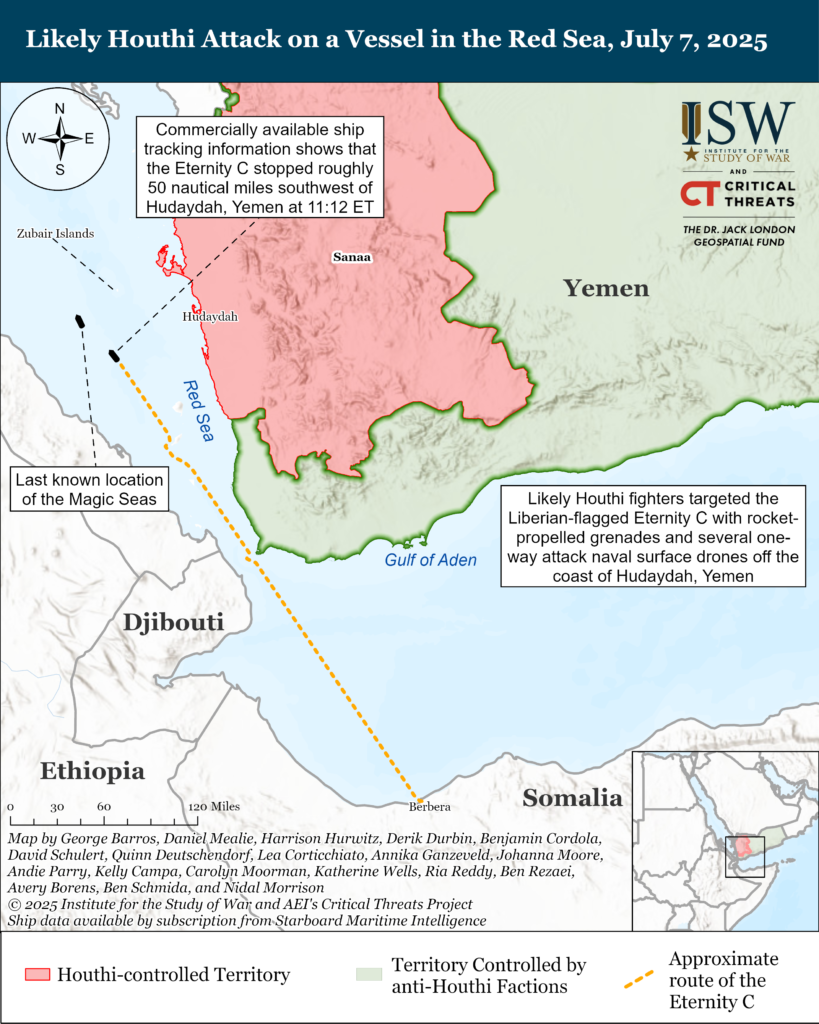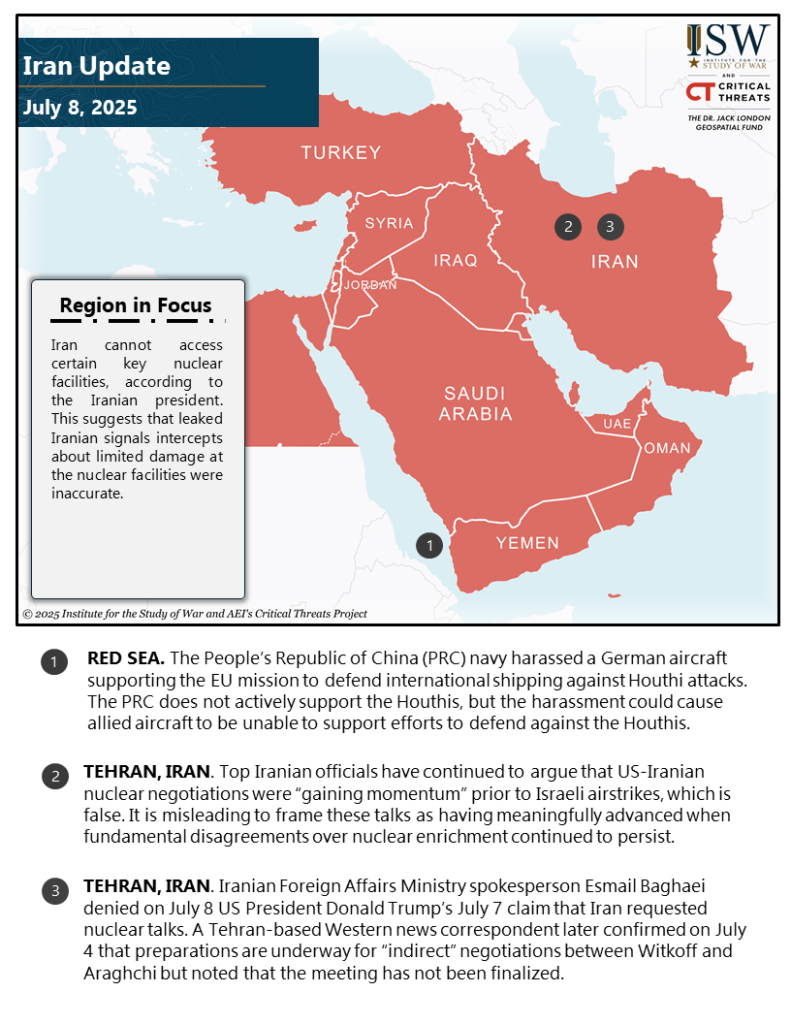Iranian Foreign Affairs Ministry spokesperson Esmail Baghaei denied on July 8 US President Donald Trump’s July 7 claim that Iran requested nuclear talks.[1] Western and regional officials told Reuters on July 8 that Iran may “drag out” the talks to avoid either renewed airstrikes if negotiations fail or “humiliation at home” if Iran accepts the US demand for zero uranium enrichment.[2] US Special Envoy to the Middle East Steve Witkoff will meet with Iranian Foreign Affairs Minister Abbas Araghchi in Oslo in the coming days for nuclear talks, according to an Axios report on July 3.[3] A Tehran-based Western news correspondent later confirmed on July 4 that preparations are underway for “indirect” negotiations between Witkoff and Araghchi but noted that the meeting has not been finalized.[4] The Iranian official position against halting uranium enrichment and missile and drone production has not changed, however. It is therefore unlikely that nuclear negotiations would have a successful outcome in the aftermath of the Israel-Iran war if the current positions remain the same.
Top Iranian officials have continued to argue that US-Iranian nuclear negotiations were “gaining momentum” prior to Israeli airstrikes, which is false. Iranian Foreign Minister Abbas Araghchi incorrectly claimed that US-Iran negotiations had “gained momentum” prior to the Israeli air campaign.[5] US President Donald Trump publicly threatened force against Iran on April 12 if Iran did not agree to a nuclear deal within 60 days of the start of talks.[6] Israel began its airstrikes on June 12-13, one day after Trump’s 60-day deadline. The United States had not altered its demand that Iran seek no uranium enrichment, and Iran had not altered its demand that it be allowed to continue enrichment. It is misleading to frame these talks as having meaningfully advanced when fundamental disagreements over nuclear enrichment continued to persist. Araghchi’s statements and tone echoed those of Iranian President Masoud Pezeshkian during his July 7 interview with American media personality Tucker Carlson, suggesting that the Iranian government is orchestrating an information campaign targeting Western audiences.[7] [8] Iran even expanded its nuclear program during the negotiating period, according to the International Atomic Energy Agency (IAEA)’s recent reports.[9] The amount of enriched uranium and the level to which it was enriched had no civilian use.
Iran cannot access certain key nuclear facilities, according to the Iranian president. This suggests that leaked Iranian signals intercepts about limited damage at the nuclear facilities were inaccurate. [10]Iranian President Masoud Pezeshkian told Tucker Carlson that US airstrikes on June 22 damaged Fordow, Natanz, or Esfahan nuclear sites, but Iran cannot access the facilities to accurately assess the damage in an interview aired on July 7.[11] Pezeshkian did not draw differences in levels of access between the different facilities. Pezeshkian’s statement demonstrates that it would have been almost impossible for Iranian officials to have accurate knowledge within days of the strikes about the extent of damage that the facilities suffered. The statement also suggests that Iran’s understanding of the exact damage within the facilities remains limited.
Israeli officials suggested that the United States would support further Israeli airstrikes against Iran if Iran attempts to either rebuild its nuclear program or move highly enriched uranium from previously targeted nuclear sites.[12] Unspecified US officials reportedly left Israeli Strategic Affairs Minister Ron Dermer with the ”impression” that the United States would support further Israeli airstrikes on Iran under certain conditions after Dermer’s meetings in Washington last week. These conditions include Iranian efforts to rebuild its nuclear program or to move highly enriched uranium from Fordow, Natanz, or Esfahan, according to two sources familiar with the matter speaking to Axios on July 7.[13] US airstrikes on these facilities on June 22 “sealed off” the enriched uranium inside the three damaged nuclear sites but did not destroy all the nuclear material or infrastructure, according to unspecified US and Israeli officials speaking to Axios on July 7.[14] The enrichment level of the nuclear material at these sites and whether Iran moved some of the enriched material prior to the strikes is unclear.
The People’s Liberation Army Navy (PLAN) harassed a German aircraft supporting the EU mission to defend international shipping in the Red Sea, which could decrease the ability of US partners to defend the freedom of navigation in the Red Sea against the Houthis. The German Foreign Affairs Ministry said on July 8 that a People’s Republic of China (PRC) PLAN ship used a laser to harass a German surveillance aircraft operating in the Red Sea in early July.[15] The German Foreign Affairs Ministry said that the PLAN ship lasered the civilian-contracted German aircraft “without any reason” or prior contact while the aircraft had been operating under the European Union (EU)’s mission to protect merchant vessels from Houthi attacks in the Red Sea.[16] The Ministry added that the aircraft and its crew, which included German army personnel, had resumed operations since the incident. The German aircraft is based in Djibouti, where the PLA has a military base.[17] The PLAN has previously used lasers to harass US aircraft operating from Djibouti, as well.[18] The United States and Australia have previously accused the PLAN of using lasers against US and Australian aircraft in the Pacific Ocean.[19] The PRC does not actively support the Houthis in the Red Sea, but PRC harassment of vessels and assets supporting the defense of international shipping can pull these assets off station and make them unable to fulfill their mission. This result, in turn, would mean that the net effect of PRC behavior supports Houthi operations even if the PRC does not intend to do so.
Likely Houthi militants conducted a complex attack targeting the Liberian-flagged bulk carrier Eternity C off the coast of Hudaydah, Yemen, on July 7.[20] Likely Houthi fighters on several small vessels attacked Eternity C with at least five rocket-propelled grenades and several one-way attack naval surface drones.[21] The United Kingdom Maritime Trade Operations (UKMTO) reported that the vessel sustained significant damage and lost all propulsion.[22] The attack killed at least two crew members.[23] UKMTO previously reported that the vessel was under continuous attack as of 3:34 AM ET on July 8.[24] The Houthis previously conducted a similar complex attack targeting the Liberian-flagged bulk carrier Magic Seas off the coast of Hudaydah, Yemen, on July 6.[25] Both vessels were traveling near the Zubair Islands at the time of the attacks, which suggests that a Houthi cell is likely operating from the Zubair Islands.[26] The Houthis previously used these islands during the October 7 War to attack vessels and appear to be doing so again.[27] It is also possible that the Houthis launched the vessels from Hudaydah and used the Zubair Islands as a way station. The Houthis have not claimed the attack at the time of this writing.

Key Takeaways
- Top Iranian officials have continued to argue that US-Iranian nuclear negotiations were “gaining momentum” prior to Israeli airstrikes, which is false. It is misleading to frame these talks as having meaningfully advanced when fundamental disagreements over nuclear enrichment continued to persist.
- Iranian Foreign Affairs Ministry spokesperson Esmail Baghaei disputed on July 8 US President Donald Trump’s July 7 claim that Iran requested nuclear talks. A Tehran-based Western news correspondent later confirmed on July 4 that preparations are underway for “indirect” negotiations between Witkoff and Araghchi but noted that the meeting has not been finalized.
- Iran cannot access certain key nuclear facilities, according to the Iranian president. This suggests that leaked Iranian signals intercepts about limited damage at the nuclear facilities were inaccurate.
- The People’s Republic of China (PRC) navy harassed a German aircraft supporting the EU mission to defend international shipping against Houthi attacks. The PRC does not actively support the Houthis, but the harassment could cause allied aircraft to be unable to support efforts to defend against the Houthis.
- Likely Houthi militants conducted a complex attack targeting the Liberian-flagged bulk carrier Eternity C and killed two crew members off the coast of Hudaydah, Yemen, on July 7.

Iranian Artesh Air Force Commander Brigadier General Hamid Vahedi inspected the 8th Tactical Airbase (TAB) in Esfahan Province and the 4th TAB in Khuzestan Province on July 7, following Israeli strikes on these bases during the Israel-Iran War.[28] Israeli airstrikes targeting the 8th TAB on June 17 and June 23 damaged runways and hangars and destroyed several Iranian Artesh Air Force fighter jets stationed at the base.[29] Israel separately struck the 4th TAB on June 21 as part of its campaign to degrade Iranian airpower.[30] The Israel Defense Forces (IDF) Air Force reported on June 23 that it struck at least six Iranian airbases across western, eastern, and central Iran to strengthen Israeli air superiority.[31] The IDF Air Force said that its strikes disabled runways and destroyed F-14s, F-5s, and AH-1 Cobra attack helicopters intended to disrupt Israeli operations, which the IDF said degraded Iran’s ability to launch counter-air missions.[32]
Iranian Assembly of Experts member Sadegh Pishnamazi called on July 8 for the “inspection” of ships and the seizure of “enemy-related cargoes” in the Strait of Hormuz to “deter future attacks and strengthen Iran’s bargaining power.”[33] The Strait of Hormuz is not Iranian waters, and inspection in these waters would be tantamount to a hijacking.[34] Pishnamazi’s remarks follow the Iranian Parliament’s June 22 approval of a measure to close the Strait of Hormuz, which awaits final approval from the Supreme National Security Council.[35] Iran has previously threatened to disrupt international shipping in response to US and Israeli strikes on its nuclear facilities.[36]
Pishnamazi also defended Iran’s decision to suspend cooperation with the IAEA and stated that the suspension “prevents foreign spies” from identifying weaknesses and launching new attacks.[37] The IAEA did not facilitate spying on Iranian facilities, and the IAEA reports were not the proximate trigger for Israel’s air campaign, as CTP-ISW has previously noted.[38] Pishnamazi urged upgrades to Iran’s nuclear facilities to meet national needs and bolster deterrence, and added that Iran should increase uranium enrichment to 90 percent to “strengthen its defensive posture and counter adversaries.”[39] The Assembly of Experts stated in May 2025 that Iran’s ”peaceful use” of nuclear technology is an ”undeniable and inalienable right.“[40] The Assembly of Experts is an 88-member elected clerical body tasked with the appointment, supervision, and removal of the Supreme Leader.[41]
The US State Department revoked the Foreign Terrorist Organization (FTO) designation for Hayat Tahrir al Sham (HTS) on July 8.[42] The State Department justified its decision to remove the FTO designation by citing the dissolution of HTS and the commitment of the Syrian transitional government to combat terrorism in all forms.[43] US Secretary of State Marco Rubio said that removing the FTO is part of the Trump administration’s vision of a ”stable, unified, and peaceful Syria.”[44] Trump signed an executive order on June 30 that terminated a US sanctions program on Syria but maintained sanctions on former Assad regime members.[45] A senior Trump administration official said that the administration intends to try to suspend the 2019 Caesar Syria Civilian Protection Act, which will require congressional action.[46] The Caesar Act dissuades long-term foreign investment into Syria out of fear of violating US sanctions.[47]
 Eurasia Press & News
Eurasia Press & News




